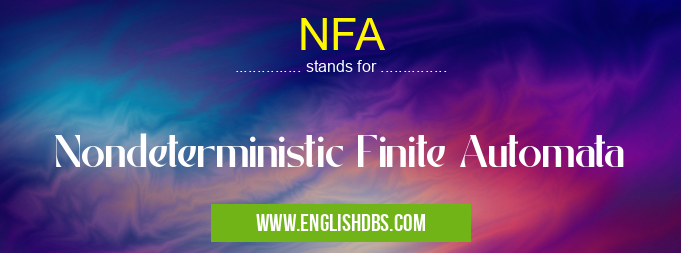What does NFA mean in GENERAL
NFA, short for Nondeterministic Finite Automata, is a computational model used to describe and analyze calculations. It makes use of a finite set of states and transitions between them, where each transition may be taken or not taken under certain conditions. The input to the NFA is an alphabet set of symbols. A state in an NFA can have multiple transitions associated with it, and this allows the model to have different behavior depending on the input being processed. In this way, NFAs are useful for analyzing languages and making decisions in complex systems.

NFA meaning in General in Computing
NFA mostly used in an acronym General in Category Computing that means Nondeterministic Finite Automata
Shorthand: NFA,
Full Form: Nondeterministic Finite Automata
For more information of "Nondeterministic Finite Automata", see the section below.
Essential Questions and Answers on Nondeterministic Finite Automata in "COMPUTING»GENERALCOMP"
What is a Non-deterministic Finite Automata?
Non-deterministic finite automata (NFA) are machines used to recognize patterns of input. It is a mathematical model that is defined by a set of states, their transitions, and an initial state. The transition between the states can be either deterministic or non-deterministic. In other words, it is possible for an NFA to take multiple paths through its states for the same input string.
What role does an NFA have in formal language theory?
An NFA plays a very important role in formal language theory as it allows us to formally define given languages and study them more effectively. By using NFAs, we can check whether strings belong to specific languages or not; test if two languages are equal or not; and construct new languages using existing ones. Additionally, NFAs also help us to analyze patterns in text strings more accurately.
How does an NFA differentiate between the language accepted by a DFA and one rejected by it?
A DFA will accept any string that has at least one valid path from the initial state to the final state, meaning that only strings of correct syntax will be accepted. On the other hand, an NFA will accept any string that has at least one valid path from the initial state regardless of whether it’s syntactically correct or not since it allows for multiple paths per input string.
How many final states does an NFA have?
An NFA can have zero or more than one final state meaning that they are highly flexible compared to DFAs which require exactly one final state. The number of final states in an NFA depends on the type of problem which needs to be solved and how complex the solution needs to be.
What types of problems can be solved with NFAs?
NFAs can be used for recognizing pattern matching problems such as regular expressions and text recognition tasks like speech synthesis. Additionally, they are also commonly used for formal verification applications such as model checking and program analysis since they allow us to precisely define certain properties about our systems before testing them on real hardware/software environments.
What symbols does an NFA use while processing data?
During its process, an NFA uses several symbols like 'ε', '0', '1', '*' (asterisk), etc., depending on what type of problem it's trying to solve. For instance, when dealing with regular expressions 'ε' stands for Empty String while '*' denotes Kleene closure.
What would happen if there was no initial state in an NFA?
If there was no initial state within an NFA then it wouldn't know where or when to start processing data leading to undefined behavior due to lack of definition about how input strings should be processed.
Is there any limit on how many transitions/states an NDA can have?
No, there is no limit on how many transitions/states an NDA can have since each component serves its own purpose without being limited by other components which helps make them highly flexible machines.
Final Words:
In summary, Nondeterministic Finite Automata (NFA) are useful models for recognizing patterns in strings of symbols based on their transitions between different states. They can be used to analyze languages and make decisions about whether or not given strings fit within those languages; this makes them useful tools for many applications dealing with data processing or artificial intelligence tasks such as language recognition and decision-making. With so many potential uses, NFAs have become essential building blocks in modern computing systems today!
NFA also stands for: |
|
| All stands for NFA |
